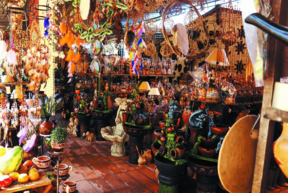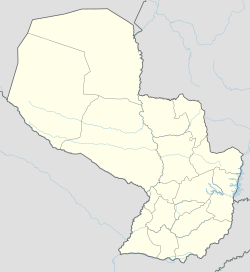Areguá facts for kids
Quick facts for kids
Areguá
Aregua
|
|||
|---|---|---|---|
|
District
|
|||
|
Clockwise from top: an artisans' market, the welcome sign in front of the main church and a view from Areguá Beach.
|
|||
|
|||
| Etymology: People from above | |||
| Nickname(s):
City of Strawberries
|
|||
| Government | |||
|
• Mayor
|
Humberto Denis Torres Fleytas (ANR) | ||
| Area | |||
|
• Total
|
105 km2 (41 sq mi) | ||
| Elevation | 70 m (230 ft) | ||
| Population | |||
|
• 2023 estimate
|
83,028 | ||
|
• Density
|
642.73/km2 (1,664.7/sq mi) | ||
| Time zone | UTC-4 | ||
| Calling code | 291 | ||
| Website | https://www.municipios.gov.py/aregua/ | ||
Areguá is a special city in Paraguay. It's the capital of the Central Department. People know Areguá for its delicious strawberry products. It's also famous for its beautiful pottery and old colonial architecture. The city has historic streets made of cobblestone.
Areguá is located between Ypacaraí Lake and the Salado River. There are also hills to the west.
Contents
What Does Areguá Mean?
The name Areguá likely comes from an old language called Classical Guarani. It means "people from above" or "from up there." This name probably refers to the city's higher location. It also points to the first people who lived there, the Mbya Guarani tribes.
A Brief History of Areguá
Areguá was started by Domingo Martínez de Irala in 1538. About 200 early settlers lived near the church. They were Mercedarians, a religious group. They came with the Spanish to raise cattle. African slaves were forced to work on these farms.
By the late 1800s, Areguá became a popular place for tourists. Many writers, artists, and smart people from nearby areas would visit in the summer.
Areguá officially became a district on November 12, 1862. This was decided by Francisco Solano López.
In 2019, UNESCO named Areguá a "City of Crafts and Folk Arts." This means it's recognized for its amazing crafts and traditional art. It's part of UNESCO's Creative Cities Network.
Geography and Climate
Areguá is divided into many smaller areas called "companies." There are twenty-four of these areas, each with its own name.
Areguá's Weather
Areguá has a mild climate. In summer, temperatures can reach 40°C (104°F). In winter, the average temperature is around 0°C (32°F). The city gets about 1377mm (54 inches) of rain each year. This rain is spread out throughout the year.
Who Lives in Areguá?
The population of Areguá is about 67,847 people. About half of these residents are female, and the other half are male.
Culture and Traditions
Areguá's economy mostly relies on strawberry farming. The city is also famous for its pottery. Making pottery is a growing industry in the area.
Every year, Areguá hosts the Strawberry Expo. This is a month-long festival celebrating strawberries. Farmers and producers sell fresh strawberries and many strawberry products. You can find juice, cakes, ice cream, and even strawberry empanadas and pastafrolas.
The city also has a big celebration called a patronal festival. It happens on February 2, honoring the Virgin of Candelaria. The celebrations last about ten days. They include a novena (nine days of prayer), a folk festival, and serenades. There's also a procession where the Virgin's image is carried to schools and other places.
Cool Places to Visit
Areguá has a historic area around Avenida del Lago (Lake Avenue). This avenue goes from a church on a hilltop down to Ypacaraí Lake. In 1997, Paraguay's government said this area was a National Heritage Area. This means it's very important to protect.
Isla Valle is a local group that helps protect the environment. They make sure fishing in the lake is done in a safe way.
Another fun place to visit is the Centro Artesanal de la Cuenca. At this center, artists from the region show off their pottery and crafts. Areguá also has several art galleries. These include Guggiari Arte and El Cántaro.
The Koi and Chorori hills are interesting natural spots. Koi Hill is special because it has unique rock formations. These are hexagonal (six-sided) sandstone shapes. Koi Hill is a protected heritage site. It was named a Natural Monument in 1993.
Famous People from Areguá
The well-known Paraguayan writer Gabriel Casaccia was born in Areguá.
See also
 In Spanish: Areguá para niños
In Spanish: Areguá para niños
Images for kids











